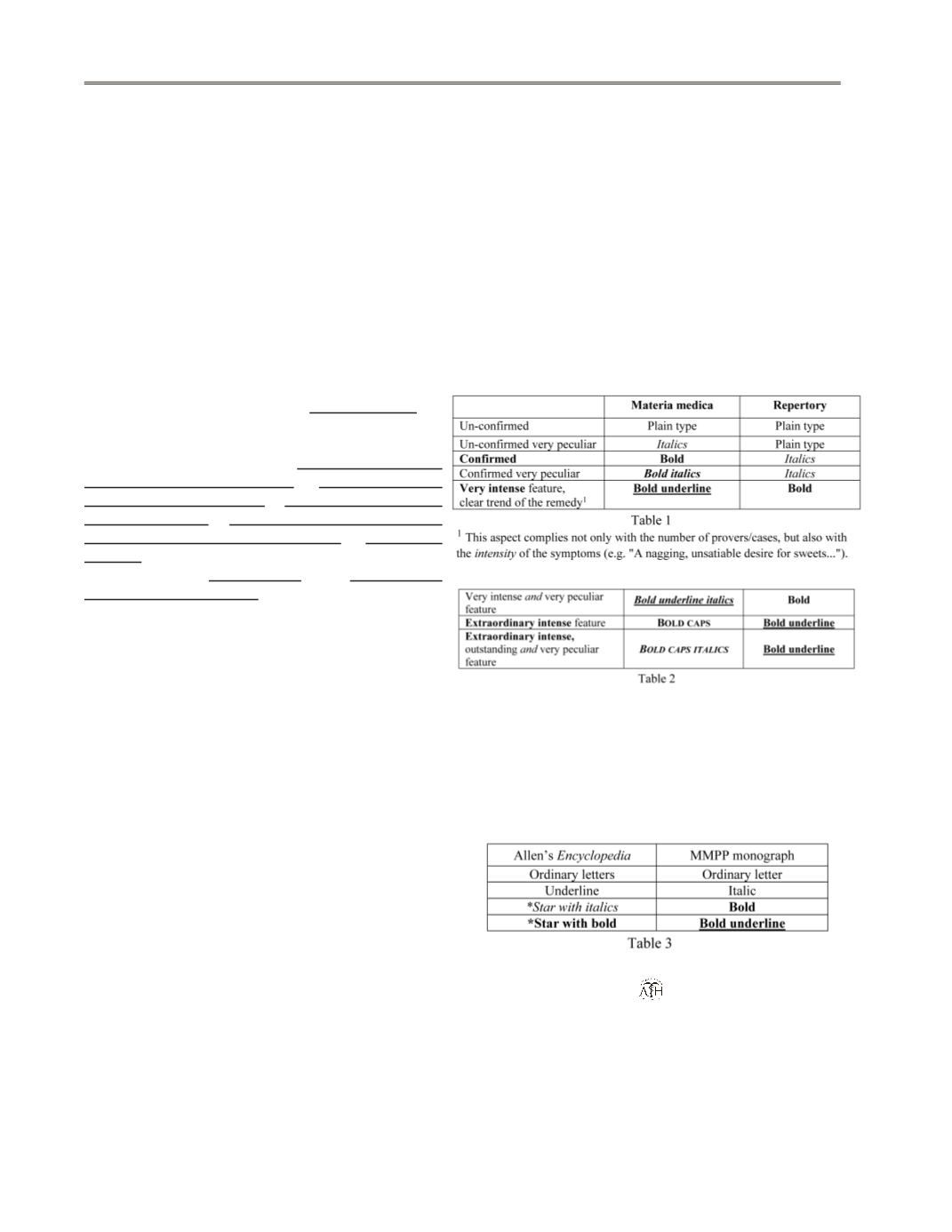
Volume 108 Number 2
64 AJHM Summer 2015
Tim Fior, MD
In the materia medica section of the monograph, we use
only the
more characteristic
symptoms, as did Hering in
his “Guiding Symptoms.” Symptoms are chosen based on
whether they are likely to be helpful in finding or prescrib-
ing the remedy. And since all the included symptoms are
more
characteristic we emphasize (through use of typo-
graphical grading) only those that are
most
characteristic.
The most characteristic symptoms are put in
italics
.
When these symptoms are also well-confirmed they are
put in
bold
. When symptoms are most characteristic, well-
confirmed and presented in a great percentage of provers
or cases and/or are almost unique to this remedy in our
materia medica, we present them in
bold-underlined
.
For example, in the monograph of
Secale
, the follow-
ing symptoms were put in bold-underlined as the signa-
ture symptoms of the remedy: 1)
cold surface, but can-
not bear any coverings on them
, 2)
prickling, tingling,
formication and numbness, 3) all secretions and excre-
tions are offensive,
4)
the symptoms of decomposition,
and the total absence of reactive power, 5) threatening
abortion, and 6) migraine
.
The symptoms
“dilated pupils”
and “
diminution in
the frequency of the pulse”
were also put in bold under-
lined
because there are so universal in this remedy. The
former is pathognomonic of ergot poisoning while the in-
tensity of the latter is unique in our materia medica.
These rules of emphasizing the most characteristic
symptoms apply equally to symptoms within cases (i.e. in
the “Cases” section, which is at the end of the monograph).
The following is a case excerpt with which we will il-
lustrate the rules of emphasis/grading: “I found the patient
greatly exhausted, thin, great pallor. Severe pain in right
kidney, unable to lie on that side. His nights were disturbed,
owing to the frequent urination. Great smarting and milky,
being heavily ladened with pus. At times he would have
profuse bright red hemorrhages.”
In this patient with gonorrhea,
all
the symptoms are
characteristic, but we have to emphasize only what is the
most characteristic. The most characteristic symptom here
is the “profuse bright red hemorrhage,” and as it is a well-
established, most characteristic symptom of Erigeron, it
will be therefore be in bold. Second, the intensity of the
pain, the location of the pain (right kidney), and the modal-
ity (worse lying on that side) are also very characteristic
and will be italicized. This case excerpt would therefore
appear as follows: “I found the patient greatly exhausted,
thin, great pallor.
Severe pain in right kidney
,
unable to lie
on that side.
His nights were disturbed, owing to the fre-
quent urination. Great smarting and milky, being heavily
ladened with pus. At times he would have
profuse bright
red hemorrhages
.”
Grading of the symptoms:
The repertory doesn´t show how
peculiar
a symptom
is; this is only given in the text. But this is by design, as
the repertory is meant only to give
hints
on the remedies
and how often they were verified, not on the extent of their
peculiarity.
Correspondence of gradation fromAllen’s
Encyclopedia
to the MMPP monographs:
Guide to Grading/Emphasizing Characteristic Symptoms


